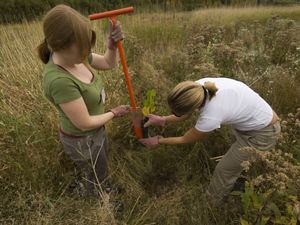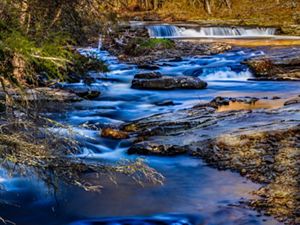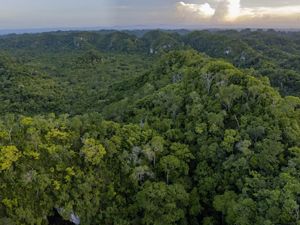Southern Deltas: Restoration and Conservation
From Marginal to Thriving
How landowner Max Woodfin is giving new life to his family's farm by planting 36,000 trees on his property.
Max Woodfin is unfazed by the cold February winds blowing across the Delta as he and his nephew Greg Garrison walk parallel to the team of professional tree planters on their family farm. Work is in full swing to plant the challenging alluvial soil with more than 36,000 strategically selected varieties of oak and other hardwood seedlings to reforest the Woodfins’ farm in an area known as Dark Corner.
Located off Highway 17 between Brinkley and Cotton Plant in the Arkansas Delta, the area has hardwood history in its name. “The cypress grew so thick here, you couldn’t see the sun standing here on a sunny day,” says Woodfin.
Quote: Max Woodfin

Today is a tribute to my father and mother, who gave back to their community with their time and talent.
Breaking New Ground in a Family Legacy of Farming
The Woodfin family has owned these 235 acres since the 1920s, farming 125 acres since the 1930s. They grew cotton until the 1950s, Woodfin says, and then moved on to soybeans, rice, corn, milo and winter wheat.
He pauses to take in this moment: his family’s farm serving as the center of a unique event with The Nature Conservancy (TNC). “How does it feel to be the first, Max?” yells Jason Milks, TNC’s U.S. reforestation program director.
Milks navigates plowed rows to greet Woodfin, whose expression moves quickly from stunned amazement to a wide satisfied smile upon hearing the news: The Woodfins are the first landowners to sign on to TNC's Floodplain Reforestation Program to reforest their land for the next 30 years.
“We were delighted, amused and a little bit amazed to find out that we were the first landowners to participate in this program,” he says.
Flooding and Lost Revenue
The Woodfin family's farm is located in a region that’s experiencing intense impacts of climate change, including more frequent and devastating floods. Over the last decade, flooding in the Mississippi River Delta region has hit historical highs.
Floodplain Reforestation Program
Farmers like the Woodfins enroll their unfarmable land in the program, which is then replanted with native hardwood trees. Farmers receive payment for the use of the land for 30 years, while the restored forest floodplain creates carbon credit opportunities, provides flood protection, improves water quality, opens up new recreational opportunities and restores ideal habitat for fish and animals. Learn More
Before they were converted to agriculture, forested floodplains in the region allowed room for the river to expand during times of flooding. Floodplains provide ideal habitat for migratory birds and serve as nursery habitat for freshwater fish.
More than 75% of Mississippi River Delta floodplains are now developed for agriculture—but climate change is making it difficult for many landowners to continue farming in the region. Many low-lying acres that once sustained crops are now seasonally or permanently inundated with water. This means a loss of revenue for the landowner.
The Floodplain Reforestation Program is designed to help farmers make their land more resilient and earn revenue in the process.
A win-win for nature and families
“This site is a dream for reforestation,” says Milks as he surveys the teams skillfully planting the seedlings. “The fact that this sits in the elbow of hundreds of surrounding acres of conservation work that has been done in the area in the last several decades, and this is the last piece to be reforested, is serendipity or divine intervention. I’m grateful!”
For the Woodfins, putting the farm into the reforestation program is also about family legacy.
Quote: Jason Milks
“Today is a tribute to my father and mother, who gave back to their community with their time and talent. They were not wealthy people, so they gave back in ways that best suited their abilities,” he says. “None of their children or grandchildren are monetarily wealthy either, so Munnie and Pop would have been thrilled to see us give back with their land.”
When the property was reassessed, Woodfin discovered another benefit to enrolling in the program. The reforested portion of the land was reclassified as timberland, rather than agricultural, resulting in a county property tax reduction of 84%.
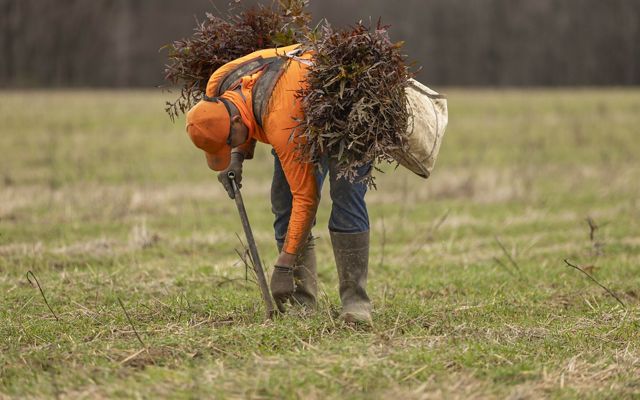
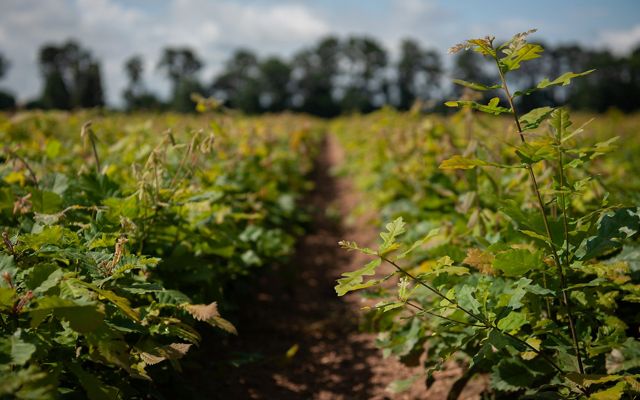
A long relationship with The Nature Conservancy
The Woodfins' relationship with TNC started when the organization sought his permission to access the Bayou DeView from his farm to confirm a kayaker’s sighting of an ivory-billed woodpecker—a bird not seen in decades. For a few months, the Woodfin family farm was ground zero for TNC scientists and conservation partners who hoped to find the elusive bird’s habitat.
Fast forward two decades. When it was time for TNC to reach out to farmers about the new reforestation program, Woodfin was one of the first landowners who received a call. The timing was perfect, he says, due to the family’s growing frustration during the last 20 years of farming.
Quote
The reforested portion of the land was reclassified as timberland, rather than agricultural, resulting in a county property tax reduction of 84%.
“I don’t want to cast any aspersions on native deer,” he whispers as if deer are eavesdropping, “but we were losing crops to deer because this was one of the few fields in production. The deer thought of this as their salad bar.”
With few good options for managing the crops to keep deer away, Woodfin says, TNC’s offer to reforest his farm was worth serious consideration. “What we see here is a reforestation program that will blend with the natural environment that was disturbed more than 100 years ago to put the land into farm production.”
A great place for wildlife and nature
Greg Garrison, Woodfin’s nephew, remembers his grandfather, Harold Woodfin, bringing him to the property when he was young.
“It’s just a beautiful place,” he says. “It’s part of our heritage and part of our story. I hope my kids appreciate that and in 30 years, when our reforestation agreement ends, it will be their decision to continue. I love that we’re using some common sense and purposeful thought to make a great place for wildlife and nature in general.”
Woodfin encourages Delta landowners to enroll their marginal land into the Floodplain Reforestation Program. “If you have marginal acres, we would urge you to talk to The Nature Conservancy to see if your property would be a good fit for this program. The Nature Conservancy is a wonderful partner,” he says. “You’re going to benefit the environment, you’re going to benefit your own bank account, and you’re going to be helping The Nature Conservancy in their overall objectives. It’s easy.”
Stay connected for more reforestation stories.
Sign up to receive Nature News email updates about this and other projects.



